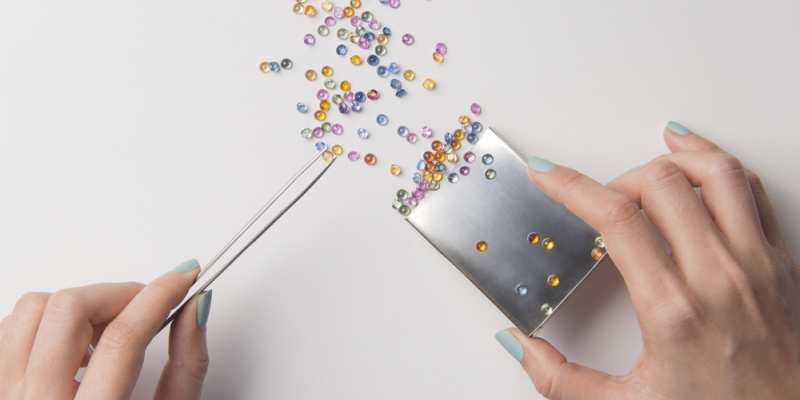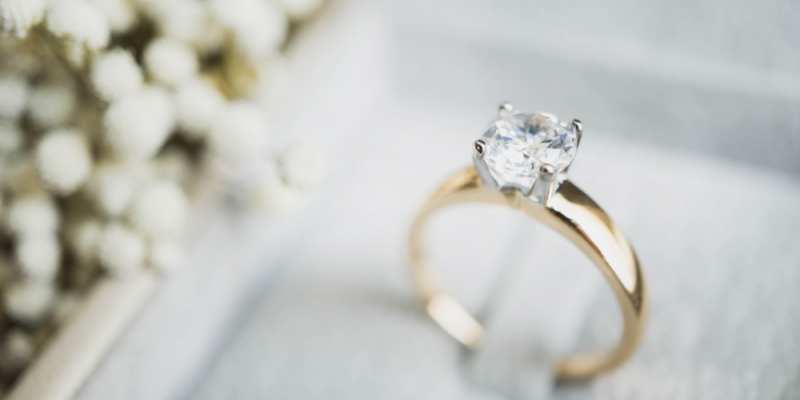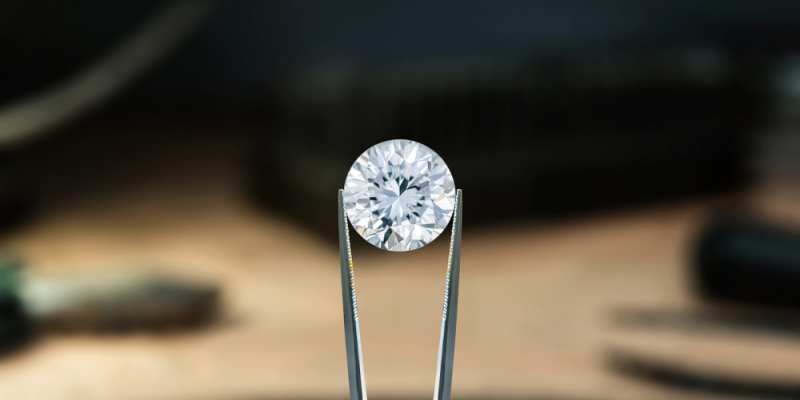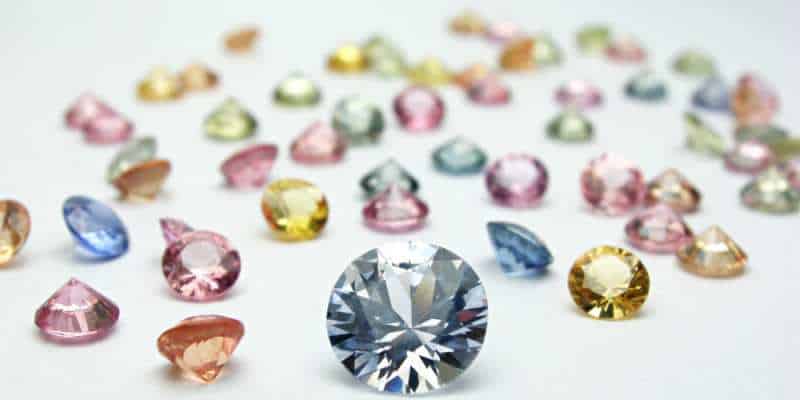Diamonds possess a mesmerizing beauty, and among the four Cs of gem grading, color is often the most recognizable characteristic. However, the grading of diamond color is more intricate than one might expect. Have you ever wondered about the range of colors that real diamonds exhibit?
Diamonds can display a variety of colors and varying intensities, all evaluated on a distinct scale. But how exactly is this scale structured, and what factors influence the color of a diamond?
In this article, we will explore the answers to these questions and more. So, without delay, let’s delve into the captivating world of diamond color.
DESIGN YOUR OWN ENGAGEMENT RING: START WITH A SETTING OR START WITH A DIAMOND. IT’S REALLY UP TO YOU!

Diamond Color & Grading
Both naturally mined and lab-grown diamonds exhibit a wide range of colors and shades. The conventional, transparent gemstones commonly seen in engagement rings are referred to as white diamonds.
On the other hand, fancy colored diamonds boast vibrant hues such as yellow, green, and pink.
The Gemological Institute of America (GIA) has established a standardized color grading scale for diamonds, ranging from D to Z. This scale is also utilized for lab-grown diamonds. All diamonds on this scale are categorized as white, even if they have a slight yellowish undertone at the lower end.
Interestingly, when it comes to grading, diamond color is assessed based on the absence of color. A diamond with less color receives a higher grade. The presence of color can diminish the diamond’s sparkle, resulting in a less brilliant appearance compared to colorless diamonds.
Let’s now explore the color grading chart:
| Diamonds Color Grades | Color Visibility |
|---|---|
| D | Colorless |
| E | Colorless |
| F | Colorless |
| G | Near Colorless |
| H | Near Colorless |
| I | Near Colorless |
| J | Near Colorless |
| K | Faint Yellow |
| L | Faint Yellow |
It’s important to note that color is a natural characteristic of diamonds, as they are composed of carbon deposits. Over millions of years, as these gems formed beneath the Earth’s crust, traces of certain elements caused them to develop a brownish or yellowish tint.
It is common for diamonds to exhibit some degree of tint, which can vary in tone, saturation, and hue, rather than being completely colorless.
Gemologists grade the color of a diamond by observing its body color against a white background while the diamond is face down. They compare the diamond to other stones with known color grades, and in some cases, they may use a set of cubic zirconia verified by the GIA for color comparison.

Basics Of The Diamond Color Scale
Our diamond color scale follows a letter-grade system, where D is the highest grade and Z is the lowest. Previously, diamonds were graded using a range that included AAA, AA, A, and B, but the introduction of the new scale aimed to eliminate confusion.
Diamond Color Grades D-F
Diamonds in this range are either colorless or have extremely subtle traces of color that can be detected by a trained gemologist. To accurately identify the color, these diamonds need to be compared to diamonds of lower or higher grades. Less than 1% of all gem-quality diamonds fall into this category.
Diamond Color Grades G-J
Diamonds falling within this range exhibit minor hints of color, which can generally be discerned by trained gemologists. The G and H color diamonds are particularly popular as they strike a balance between minimal color and value. I/J colored diamonds may have slight obstructions to their sparkle, but they still possess beautiful brilliance and significant value. This color range represents the top 15% of all gem-quality diamonds.
Diamond Color Grades K-M
Diamonds graded as K, L, and M often display a faint brown or yellowish tint. This color does have an impact on the diamond’s sparkle, resulting in a slightly diminished appearance. Diamonds in this range make up the top 40% of all gem-quality diamonds.

Understanding Each Diamond Color Grade
If you’re unsure about which diamond color to choose or how to achieve the desired color and sparkle within your budget, we’ve provided detailed information on each specific diamond color below.
Diamond Color D
Diamonds with a color grade of D symbolize perfection and possess the highest level of color purity. These diamonds are extremely rare and exhibit no discernible shades of color. To the naked eye, D color diamonds appear similar to E and F colors. They look stunning when set in platinum, gold, rose gold, or yellow gold, although some color from the setting may reflect through the diamond.
Diamond Color E
E color diamonds are visually beautiful, similar to the previous color grade, and boast high color purity. They are also very rare and exhibit almost imperceptible color shading. Even under ten times magnification, an E color diamond won’t show any hints of yellow.
Diamond Color F
F color diamonds possess excellent beauty and display a minimal shade of color that is undetectable to untrained individuals. They are highly sought after for their rarity and high color purity. If you’re looking for a diamond that appears colorless to the naked eye, an F color diamond is an excellent choice. They are also more affordable compared to D and E color diamonds.
Diamond Color G
G color diamonds are exquisite and feature minor traces of color that can only be identified by professionals. They are the most popular choice as they offer a great combination of value and beauty. G color diamonds can be paired with white gold or platinum settings to minimize any traces of yellow. They also look stunning with yellow and rose gold.
Diamond Color H
H color diamonds possess a captivating appeal, with a slightly detectable shade of color that doesn’t affect their brilliance. They are a popular choice due to their value and visual attractiveness. H color diamonds are ideal if you want to prioritize characteristics like clarity and carat while still enjoying a beautiful diamond.
Diamond Color I
I color diamonds exhibit some color shading that can be identified by a trained eye, but they still deliver excellent brilliance. Since the hue is not noticeable to an untrained eye, I color diamonds provide excellent value. They can be a good choice as the yellow color is not too apparent. Consulting a gemologist can help you find an I color diamond that faces up white.
Diamond Color J
Diamonds with a color grade of J offer elegant sparkle and value, provided they are well-cut. They feature a shade of color that is only detectable by professionals. Similar to previous grades, it is advisable to consult a gemologist to find a suitable diamond that faces up white. Additionally, consider the diamond’s shape, as certain cuts can accentuate the color of the diamond.
Diamond Color K
K color diamonds maintain their sparkle without compromising the stone’s brilliance. Some color shading may reflect light, but it can be challenging for untrained individuals to discern the color grade. Keep in mind that these diamonds may appear slightly yellow to the naked eye, particularly for sizes larger than 1.50 carats.
Diamond Color L
L color diamonds possess a lovely appearance and are considered white diamonds, as the color does not detract from their sparkle. Some hues may be noticeable to the untrained eye, especially when viewing the diamond from the side. L color diamonds look particularly stunning when set in yellow gold, as it minimizes the contrast between the diamond and the background. It’s recommended to consult with a professional before purchasing an L-color diamond to ensure it aligns with your preferences.

Diamond Color & Prices
While the distinctions in diamond color may be subtle, the variations in pricing are significant. The price difference between each color grade can range from 8% to 25% or more.
For those who seek perfection, diamonds in the D to F color range are an excellent choice. If value is a priority, colors in the I to K range are often favored. It’s important to note that diamonds of all colors exhibit brilliance and fire.
Choosing a lower color diamond means accepting minor visible differences, but it also translates to noticeable cost savings. The most substantial cost difference is typically between G and F color grades, which is why G color is the most popular choice.
The choice of metal can influence the perception of diamond color. Lower-color diamonds often appear stunning in yellow gold settings as the color of the setting reduces the contrast between the diamond and the background. Additionally, the type of setting and the amount of metal used can impact the display of the diamond’s color and sparkle, so it’s worth considering when selecting a color grade.
The shape of a diamond also plays a role in how much color is visible. Fancy cuts such as oval, marquise, and pear tend to show more color near their edges and points, while cuts like emerald, princess, Asscher, and radiant reflect more color in the body. Regarding size, color can become more apparent as the carat weight increases, so higher color grades are recommended for larger diamonds.
Fluorescence, which is a diamond’s reaction to UV light, can affect its color. Contrary to some misconceptions, fluorescence can be advantageous. In higher color grades (D to G), fluorescence should be “None” or “Faint” to avoid any potential negative effects. However, in colors I to L, medium or strong fluorescence can visually enhance the diamond’s appearance by making the color appear slightly whiter and improving the visibility of any yellowish tint.
Overall, diamonds with fluorescence are generally considered more attractive than those without, as long as the level of fluorescence is suitable for the color grade.

Diamond Color Purchasing Tips
For the best combination of appearance and value, we recommend diamonds with color grades ranging from G to J. This range is suitable for most carat weights. However, if you desire a diamond above 1 carat, it’s advisable to stick with G or H color grades.
When it comes to larger diamonds, it’s important not to compromise on color. Alongside the actual cut, color is the most crucial factor to consider when selecting a diamond.
Once the diamond is set in a piece of jewelry, its color becomes more challenging to discern. An H color diamond can appear as colorless as a D when it is mounted.
The color of the mounting can impact the perception of the diamond’s color. Yellow gold settings tend to minimize the visibility of any yellow tones in the diamond, while white metal mountings can make the color more apparent. Rose gold settings can have a similar effect, though to a lesser extent. White gold and platinum settings make yellow tints more noticeable.

Bottom Line
To provide a definitive answer to the question “What colors do real diamonds shine?” let’s consider the following:
Real diamonds can exhibit a wide range of colors and qualities. Some diamonds are classified as white, pure, and transparent, while others may have a yellow or brown tint. The Gemological Institute of America (GIA) uses a standardized scale from D to Z to grade diamonds based on their color.
Typically, diamonds with noticeable tints are considered less valuable. On the other hand, colorless diamonds are generally more expensive and are often preferred for engagement rings. However, it’s worth noting that fancy colored diamonds are exceptionally rare and can display vibrant hues such as blue, yellow, pink, and even red.
The shape, size, and choice of precious metal used in the setting can also influence the appearance of a diamond’s color, as well as its fluorescence properties.
If you have any concerns or need expert advice, it’s recommended to consult a professional gemologist who can provide guidance and answer any questions you may have regarding your diamond selection.


